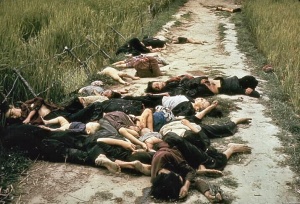Difference between revisions of "Vietnam War/My Lai Massacre"
(Added: latitude, longitude, type, locations, ON_perpetrators.) |
(update) |
||
| Line 1: | Line 1: | ||
{{Event | {{Event | ||
| − | |description=The systematic, cold-blooded murder and | + | |description=The systematic, cold-blooded murder, butchery and rape of 504 Vietnamese civilians including 173 children by a company of 115 US army soldiers. |
|website= | |website= | ||
|image=My Lai massacre.jpg | |image=My Lai massacre.jpg | ||
| Line 28: | Line 28: | ||
|ON_perpetrators=Task force from the United States Army Americal Division 2LT. William Calley (convicted and then released by President Nixon to serve house arrest for two years) | |ON_perpetrators=Task force from the United States Army Americal Division 2LT. William Calley (convicted and then released by President Nixon to serve house arrest for two years) | ||
}} | }} | ||
| − | The 26 soldiers charged | + | The 26 soldiers charged who committed [[rape]] and [[murdered]] hundreds of men, women, children and infants, eventually served a total of only 3½ years under house arrest. [[Seymour Hersh]] broke the story in [[1969]].<ref>https://www.cbc.ca/radio/thecurrent/the-current-for-june-14-2018-1.4704658/how-reporter-seymour-hersh-uncovered-a-massacre-and-changed-the-vietnam-war-dialogue-1.4704660</ref><ref>https://www.democracynow.org/2018/6/20/remembering_the_my_lai_massacre_seymour</ref><ref>https://www.history.com/this-day-in-history/seymour-hersh-breaks-my-lai-story</ref> |
| + | |||
| + | ==Developments before the massacre== | ||
| + | In 1968, an American journalist, [[Jonathan Schell]], wrote that in the Vietnamese province of Quang Ngai, where the Mỹ Lai massacre occurred, up to 70% of all villages were destroyed by the [[air strikes]] and artillery bombardments, including the use of [[napalm]]; 40 percent of the population were refugees, and the overall civilian casualties were close to 50,000 a year. Regarding the massacre at Mỹ Lai, he stated, "There can be no doubt that such an atrocity was possible only because a number of other methods of killing civilians and destroying their villages had come to be the rule, and not the exception, in our conduct of the war".<ref>https://www.counterpunch.org/2017/03/21/my-lai-massacre-49-years-later/</ref><ref>http://archive.today/2020.11.14-125159/https://en.wikipedia.org/wiki/M%E1%BB%B9_Lai_massacre</ref><ref>The New Yorker, Volume 45, Issues 41-45, 1969, p. 27</ref><ref>https://books.google.co.uk/books?id=0LUYDAAAQBAJ&pg=PA175</ref> | ||
| + | |||
| + | |||
{{SMWDocs}} | {{SMWDocs}} | ||
| + | ==References== | ||
| + | {{Reflist}} | ||
| + | {{stub}} | ||
Latest revision as of 01:32, 19 November 2020
 | |
| Date | 16 March 1968 |
|---|---|
| Location | Son My, village, Sơn Tịnh District, of, South Vietnam |
| Coordinates | 15.178333, 108.869444 |
| Perpetrators | US Army |
| Blamed on | Task force from the United States Army Americal Division 2LT. William Calley (convicted and then released by President Nixon to serve house arrest for two years) |
| Type | Massacre |
| Deaths | 504 |
| Injured (non-fatal) | ?"?" is not a number. |
| Exposed by | Seymour Hersh |
| Description | The systematic, cold-blooded murder, butchery and rape of 504 Vietnamese civilians including 173 children by a company of 115 US army soldiers. |
The 26 soldiers charged who committed rape and murdered hundreds of men, women, children and infants, eventually served a total of only 3½ years under house arrest. Seymour Hersh broke the story in 1969.[1][2][3]
Developments before the massacre
In 1968, an American journalist, Jonathan Schell, wrote that in the Vietnamese province of Quang Ngai, where the Mỹ Lai massacre occurred, up to 70% of all villages were destroyed by the air strikes and artillery bombardments, including the use of napalm; 40 percent of the population were refugees, and the overall civilian casualties were close to 50,000 a year. Regarding the massacre at Mỹ Lai, he stated, "There can be no doubt that such an atrocity was possible only because a number of other methods of killing civilians and destroying their villages had come to be the rule, and not the exception, in our conduct of the war".[4][5][6][7]
The Official Culprit
| Name |
|---|
| Task force from the United States Army Americal Division 2LT. William Calley (convicted and then released by President Nixon to serve house arrest for two years) |
References
- ↑ https://www.cbc.ca/radio/thecurrent/the-current-for-june-14-2018-1.4704658/how-reporter-seymour-hersh-uncovered-a-massacre-and-changed-the-vietnam-war-dialogue-1.4704660
- ↑ https://www.democracynow.org/2018/6/20/remembering_the_my_lai_massacre_seymour
- ↑ https://www.history.com/this-day-in-history/seymour-hersh-breaks-my-lai-story
- ↑ https://www.counterpunch.org/2017/03/21/my-lai-massacre-49-years-later/
- ↑ http://archive.today/2020.11.14-125159/https://en.wikipedia.org/wiki/M%E1%BB%B9_Lai_massacre
- ↑ The New Yorker, Volume 45, Issues 41-45, 1969, p. 27
- ↑ https://books.google.co.uk/books?id=0LUYDAAAQBAJ&pg=PA175